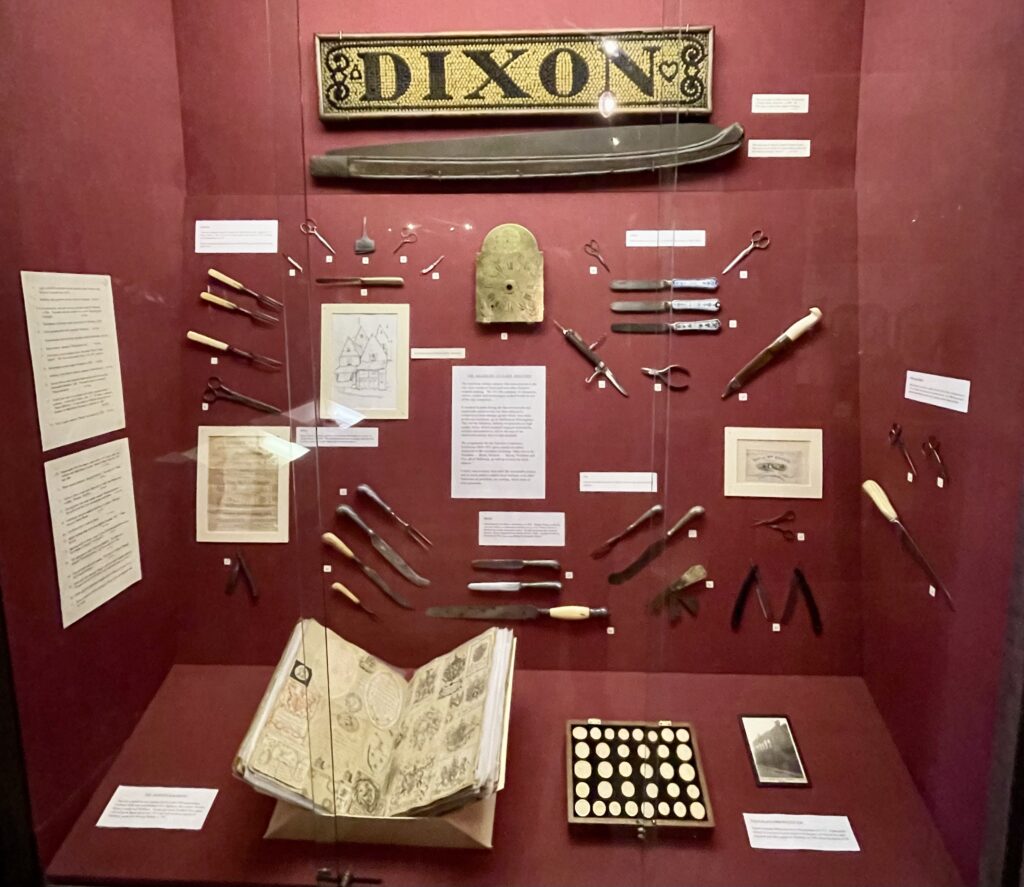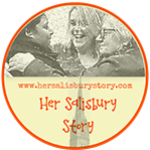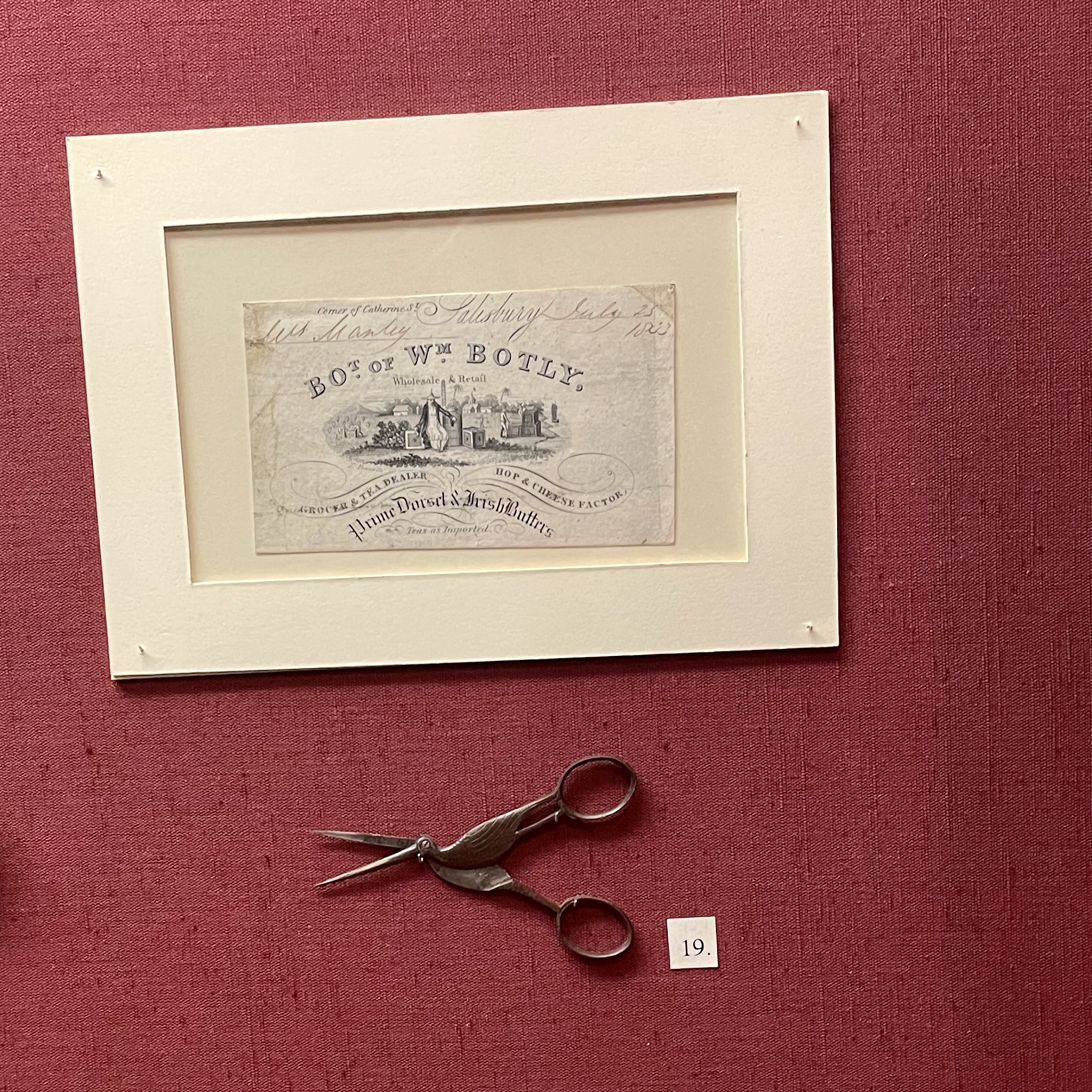Jane Botly née Silverthorne (1779-1856) was a Salisbury girl, christened in St Thomas’s Church.1 In 1808, at age 28 she married Henry Botly,2 a 41-year-old widower, who was a cutler, trading in Salisbury.3
Henry was a respectable businessman, a cutler in Ox Row whose customers included King George III.4 The cutlers were one of the oldest and most prestigious guilds in Salisbury.5 Over the centuries, sword-makers became suppliers of domestic cutlery. After Sheffield and Birmingham developed cheaper products, Salisbury kept its reputation for quality ware.
Henry had family connections to the trade: The Snooks, who were established cutlers in Salisbury, were relatives on his mother’s side.6 Henry’s first wife had died in 1792, but he continued to live in Salisbury7. He married Jane Silverthorne in 1808 and shortly afterwards, their six children were christened together at St Thomas’s Church.8
By the time Henry died in 1828, when Jane was 49, they’d had three further children, two of whom had died young. She and Henry had been running the business with the help of oldest son Henry, now 30, while George (18) was learning the trade and Mary (10) was still at school. Anne (26), Elizabeth (21) and Jane (20) were all unmarried, so newly-widowed Jane was still directly responsible for six of the children. Only William (aged 24) had left home, to become a grocer in Catherine Street.9

After her husband’s death, Jane continued the business in her own name, even though it would have been customary for an adult son to take over as head of the business. Her husband had expanded the business and been the only jeweller listed in Salisbury.10 Two years after her husband’s death, Jane had expanded the business further and was now advertising under her own name as cutler, silversmith & jeweller.11 In 1830 Jane contributed to a display of various local trades for the visit of the Duchess of Kent, the mother of the future Queen Victoria, with some success.12 The Salisbury Museum display of locally made items includes embroidery scissors made in the form of a stork, c1850 and stamped “Botly Sarum” and cutthroat razors made by Botly. Under Jane’s guidance the business grew until the family were running three cutlery businesses: Jane was still running their original premises at 9 Ox Row,13 Henry had taken over the Snook business at Catherine Street,14 and George was running a business in Reading with one of Jane’s grandson’s as an assistant and Mary also living there.15


Jane died at the age of 77.16 At that time, her sons Henry and William were still trading in Catherine Street;17 youngest son George was a jeweller and watchmaker in Reading; 18 and daughters Ann and Elizabeth had both made prosperous marriages.19 When she died Jane left her daughters Mary and Jane comfortably off in their old age.20
Jane Botly ran the Ox Row business for 28 years, from Henry’s death to her own, and had enabled one of Salisbury’s most prestigious trades to flourish for another generation.21
Written and researched by Brian Evans, edited by Anne Trevett and S.Ali.
Notes
1 Jane was born on 16 November 1779 and christened at the same time as her older sister Betty and younger sister Hester by their parents Ambrose and Hester Silverthorne.
(St Thomas’s parish register 1783).
2 Henry was born in 1766 and baptised at St James’s Westminster.
(St James’s parish register)
3 They married in London on 30 June 1808, both “of this parish” although the evidence suggests they were both living in Salisbury at the time. Jane marked the certificate with a cross as she couldn’t write her name. The witnesses were S.Botly and [M?].Botly. Henry signed as “Botly” but the certificate was made out as “Botley”.
(St James’s Clerkenwell parish register).
4 “His Majesty’s most customary commission to the firm was for the making of ornamental scissors for presentation to the ladies of his court.”
(Industrial Great Britain, entry for James Macklin & Son).
5 The Salisbury guild of “Sadullers, Cotelers, Peurters, Pynners and Cardmakers” is first documented in 1440.
(Haskins 370-1).
6 By 1791 William Snook had taken his son William, aged 34, into partnership in Catherine Street whilst his sister’s son Henry Botly, aged 25, had set himself up in business as a cutler in Ox Row.
Botly and Snook & Son were each listed as Salisbury cutlers in 1791.
(Barfoot & Wilkes Universal British Directory)
7 He was a master cutler in Salisbury, taking on an apprentice in 1799 and again in 1803.
(Register of UK indentures 1710-1811)
8 The children were: Henry, born 26th March 1798, Anne born 1st May 1802, William, born 29th November 1804, Elizabeth, born 25th March 1807, Jane, born 4th September 1808, George, born 27th April 1810.
(St Thomas’s register of baptisms, May 1810)
The children are recorded as Jane and Henry’s and all were baptized with the surname Botly, but there is something of a mystery about this because of the difficulty with reconciling some of the dates of the marriage and births with the sparse information available in the historical record. For example there is no obvious record of any extra marriage, or any burial records to indicate that Henry had remarried and been widowed again.
9 J Pigot’s Directory, 1822.
10 J Pigot’s Directory 1822.
11 J Pigot’s Directory 1830.
12 The Salisbury and Winchester journal printed the following: “Messrs S. and H. Botly also had the honour of selling several articles of cutlery to the Duchess of Kent. Her Royal Highness and Sir John Conroy were pleased to pass the highest encomiums on a superior collection of scissors submitted to their inspection by these manufacturers. The great superiority of Salisbury cutlery has been long acknowledged. (Salisbury and Winchester Journal, 1st November 1830).
13 1851 Census 1847 f78. Her daughter Jane was still living there.
14 The Ox Row address was listed as Jane Botly in 1830, Botly & Sons in 1842 and Mrs Jane Botly in 1855. The Catherine Street address was William Snook in 1830 and 1842, Henry Botly in 1855. Henry had taken over the Snook business.
(J Pigot’s Directory 1830 & 1842; Post Office Directory of Wiltshire 1855; 1851 Census 1847 f61)
15 George was in Reading with one of Jane’s grandsons as an assistant and Mary also living there. John Henry Stevens, Ann’s oldest child, was working there in 1861.
(1851 Census 1692 f384. 1861 Census 747 f75)
16 She was still advertising in 1855. She died the following year and was buried at St Edmund’s on 4 December 1856.
17 William was trading in 1861. Henry sold the business to William Cripps in 1858.
(1861 Census 1316 f43; Industrial Great Britain, entry for William Cripps)
18 1861 Census 747 f75.
19 Ann married John Stevens, a Bishopstone farmer, who later described himself as a landed proprietor and then a retired maltster, and they had three children.
Elizabeth married George Fletcher, a tailor with premises in New Bond Street, London. The formal witnesses on the marriage certificate were William Snook and his sister Elizabeth Snook. Then Jane Botly and three of her children William, Ann & Jane also signed the certificate. This suggests that George was already a relative within the extended Botly/Snook family.
(St Thomas’s parish records 1840; Bishopstone parish records 1842-6; 1851 Census 1848 f295; 1871 Census 1958 f73; St Thomas’s parish records 1830; 1841 Census 3 f20; 1851 Census 1699 f99)
20 In 1891 they were living together in Southampton with three domestic servants.
(1891 Census 914 f24)
21 The Ox Row premises under Edward Shergold and the Catherine Street premises under James Macklin continued the cutlers’ trade.
(1861 Census 1316 f49; Industrial Great Britain, entry for James Macklin & Son)
Bibliography
Ancestry, Subscription service, https://www.ancestry.co.uk
Blade Forums, The cutlery makers of Salisbury, Blog post 15 Nov 2016, Blade Forums,
https://www.bladeforums.com/threads/the-cutlery-makers-of-salisbury.1447562/
accessed January 2021,
British Newspaper Archive, Subscription service, https://www.britishnewspaperarchive.co.uk
Chandler, John, 1983, Endless Street, a history of Salisbury and its people, Hobnob Press
Crittal, Elizabeth, 1959, A History of the County of Wiltshire, Volume 4. Agriculture & Industry, Victoria County History, https://www.british-history.ac.uk/vch/wilts/vol4
Crittal, Elizabeth, 1962, A History of the County of Wiltshire, Volume 6. Old and New Salisbury, Victoria County History, https://www.british-history.ac.uk/vch/wilts/vol6
Grace, Terry, 2020, ‘Salisbury Cutlery Industry’, Fisherton Informer, October 2020
Haskins, Charles, 1912, The Ancient Trade Guilds and Companies of Salisbury, Bennett Brothers
https://archive.org/details/ancienttradeguil00hask/page/n3
London Printing & Engraving Co, 1895, Industrial Great Britain: A commercial review of leading firms selected from important towns of England, with illustrations of England’s prominent edifices, London Printing & Engraving Co,
http://messybeast.com/1894-industrial-great-britain/1894-industrial-great-britain.htm
Accessed Jan 2021
National Library of Scotland, England & Wales OS 1:500 town plan Salisbury LXVI 15.4; 1880
https://maps.nls.uk/towns/salisbury.html
Rogers, K H, 1991, Early trade directories of Wiltshire, Wiltshire Record Society Vol 47
http://www.wiltshirerecordsociety.org.uk/pdfs/wrs_v47.pdf
Royal Commission for Historic Monuments in England, 1977, Ancient and Historical Monuments in the City of Salisbury, The Royal Commission for Historic Monuments in England,

